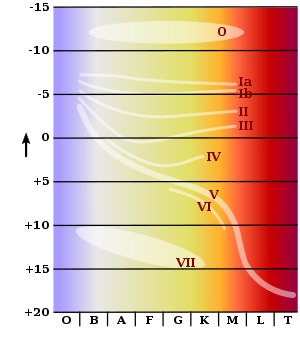Hertzsprung-Russell diagram
The Hertzsprung-Russell diagram , or HRD for short , roughly shows the evolutionary distribution of the stars . It was developed in 1913 by Henry Norris Russell and builds on the work of Ejnar Hertzsprung . If the spectral type is plotted against the absolute brightness for this purpose , characteristic line-like accumulations result with a sufficient number of entries.
Characteristic areas
Main series
The diagram shows most of the stars in the region of the so-called main sequence ( main sequence or Zwergenast ), which differ from the O-stars with an absolute brightness of about magnitude -6 to the M-stars with an absolute magnitude of magnitude of 9 to 16 moves. The stars of the main sequence form the luminosity class V. The sun is a main sequence star of the spectral class G2. Further examples of main sequence stars are Wega (A0) and Sirius (A1).
Other areas
Above the main row is the giant branch with stars of luminosity class III.
The rarer sub-giants with luminosity class IV are found between the main row and the giant branch . Their diameter is between that of the stars in the main row and that of the giant stars.
In the area of the spectral classes A5 to G0, to the left above the main sequence, there is the so-called Hertzsprung gap (not shown in the illustration), an area with noticeably few stars. It can be explained by the fact that massive stars only need a very short time to develop into giants and thus rise relatively quickly in the giant branch. Therefore, the area of the Hertzsprung gap appears relatively empty.
In addition to the crowded main sequence and the giant branch, there are the areas of bright giant ( bright giants ) with the luminosity class II and the supergiants ( supergiants ) with the luminosity class I. These areas are relatively busy but equally thin.
Below the main group are the areas of the subdwarfs with a magnitude 1–3 lower, as well as the isolated group of white dwarfs in the range of spectral classes B to G with a magnitude 8–12 lower than the stars of the main group and one very small diameter.
interpretation
The concentration of the stars in the various groups can be explained from the theory of stellar evolution . The developmental states of the stars are more or less clearly delimited from one another and can be found at very specific points in the HRD. In the course of time, the two parameters of the effective temperature and the luminosity of a star change depending on the nuclear processes in its interior, so that each star goes through a certain evolutionary path through the HRD. This happens at different speeds. Developmental states that persist for a long time are accordingly observed more frequently (e.g. in the main sequence) than rapid, only brief development stages (e.g. in the area of the Hertzsprung gap). Beyond effective temperatures of about 3000-5000 Kelvin there are no more stars in the HRD, because this is where the protostars are located, which have a very high development rate. This nearly vertical “line” is called the Hayashi line . Since the spectral type is roughly related to the temperature of the star, the HRD can be viewed as a temperature-luminosity diagram. Instead of the spectral type, you can also plot the color index of the stars, which is also a measure of their temperature. Instead of the HRD, the color-brightness diagram is obtained.
See also
Individual evidence
- ↑ The Hertzsprung-Russell diagram and the measure of the stars , by KS de Boer, Sternwarte, Univ. Bonn

